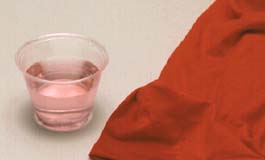Dye migration and dye sublimation occur in T-shirts containing polyester when the chemicals used to dye the polyester fibers move from the fibers into plastisol inks screen-printed on garments. Whether the dye-migration effect shows up as soon as the ink is cured or after a couple weeks, it’s an expensive surprise. To predict which T-shirt brands are more likely to discolor your prints, regularly use one or more of the following tests for dye fastness and record your results.
Dye migration and dye sublimation occur in T-shirts containing polyester when the chemicals used to dye the polyester fibers move from the fibers into plastisol inks screen-printed on garments. Whether the dye-migration effect shows up as soon as the ink is cured or after a couple weeks, it’s an expensive surprise. To predict which T-shirt brands are more likely to discolor your prints, regularly use one or more of the following tests for dye fastness and record your results. The reducer test For this test, you need about 1 cup of plastisol reducer, a white plastic cup, and a plastic glove. Fill the cup about half full of reducer. Dip a corner of the T-shirt into the reducer, let it soak for a brief period (30-60 sec), lift the T-shirt out of the reducer, and (with the glove on) squeeze the reducer absorbed by the shirt into the cup. Some of the dye in the shirt will have dissolved into the reducer. The more the reducer is discolored, the more likely you are to have objectionable dye migration. The acetone test To perform this test, you need a small quantity of acetone, a sheet of white absorbent paper (e.g., blotting paper), and an eye dropper. Slide the paper inside the T-shirt and smooth the top layer of the garment down so that it touches the paper. Place a few drops of acetone onto the fabric and let it soak down into the paper. The acetone will carry some of the dye down into the paper with it. The more dye that shows up on the paper, the more likely it is to cause dye migration problems. The heat-transfer press test Check for dye sublimation with a heat-transfer press and a sheet of uncoated bond (typing) paper with a few holes punched in it. Heat the transfer press between 330-350°F, place the T-shirt in the press, place the paper on top of the T-shirt, and close the press for about 10 sec. Open the press and inspect the paper carefully. If any discoloration appears, especially on the edges of the holes punched in the paper, it’s likely that the dye in the T-shirt will sublimate into the ink when the print is cured. The wait-and-see test This is the best test for dye discoloration that I am familiar with, yet few screen printers bother to use it. It consists of printing a test design on some sample shirts and then putting them aside to wait and see what happens. A common misconception is that dye discoloration of the printed image happens as the ink cures in the dryer. That is often true, but not always. Sometimes, dyes can take longer to migrate into the print. But in my experience, two weeks is about the longest delay you can expect before dye discoloration appears. Some printers believe that you can prevent dye-migration by running T-shirts through the dryer before printing. Actually, this may make the dye more likely to migrate into the image you print. A good way to test a colored garment’s dye-fastness is to soak a corner of the material in a small cup of plastisol reducer for a minute. After pulling the shirt out, wring any remaining reducer from the garment into the cup. The more discolored the reducer, the more likely the garment is to cause dye-migration problems.

 Case Studies2 months ago
Case Studies2 months ago
 Art, Ad, or Alchemy2 months ago
Art, Ad, or Alchemy2 months ago
 Andy MacDougall2 months ago
Andy MacDougall2 months ago
 Columns3 weeks ago
Columns3 weeks ago
 Editor's Note3 weeks ago
Editor's Note3 weeks ago
 Marshall Atkinson3 weeks ago
Marshall Atkinson3 weeks ago
 Thomas Trimingham2 months ago
Thomas Trimingham2 months ago
 News & Trends2 months ago
News & Trends2 months ago








